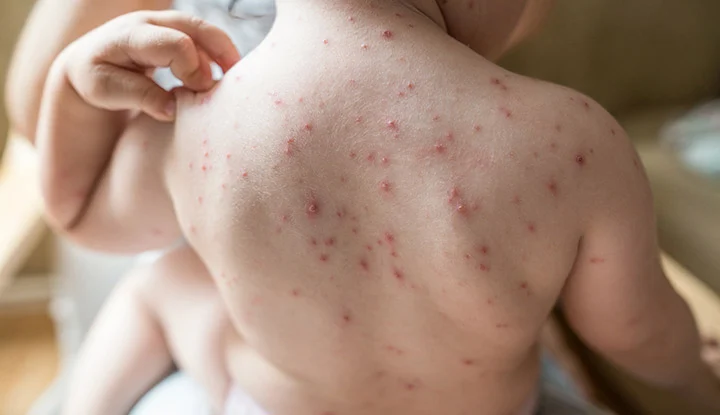Lets discuss the risks and complications of Chickenpox.
What is chickenpox?
Chickenpox is a very contagious infection caused by the varicella-zoster virus. It mainly affects kids, but adults can get it, too. The telltale sign of chickenpox is a super-itchy skin rash with red blisters. Over the course of several days, the blisters pop and start to leak. Then they crust and scab over before finally healing.

Symptoms appear within 10 to 21 days after you’ve been in contact with someone who has the virus. Most people recover in about 2 weeks. Chickenpox is generally mild, especially in children. But in severe cases, the blisters can spread to your nose, mouth, eyes, and even genitals.
Multiple chickenpox infections are extremely uncommon. Additionally, cases have decreased since the mid-1990s, when the chickenpox vaccine was launched.
A child who has chickenpox can readily infect other kids with the illness. Due to widespread childhood vaccination, chickenpox is much less common today. Before the first chickenpox vaccine was authorised in the United States in 1995, practically everyone contracted the disease. There weren’t many complications.
How is chickenpox spread?
Any age child can contract chicken pox. Your youngster may seem well for one to three weeks after exposure to the chickenpox before developing symptoms. From the day before symptoms occur until around five days after a skin rash appears, children can spread the virus.
The following methods are:
- interacting with a chickenpox-infected person
- receiving airborne infection from a sick individual who sneezes or coughs.
- obtaining bodily fluids from an infected child’s mouth, nose, or eyes.
Difference between smallpox and chickenpox
Both smallpox and chickenpox cause skin rashes, yet they are two distinct diseases. One reason is that smallpox is a far more deadly illness that can be fatal. They are brought on by many viruses.
Even while the two diseases both cause rashes, the rashes themselves appear differently and develop at different times. As opposed to the chickenpox rash, which appears in waves, smallpox pustules are identical to one another. The individual spots don’t all have the same appearance, and while some blister, others form scabs.
There is yet another significant distinction. Smallpox has been eradicated (wiped out) thanks to a large global vaccination campaign.
Symptoms of Chickenpox
The chickenpox rash, which is characterised by itchy blisters and typically lasts five to ten days, occurs 10 to 21 days following virus exposure. One to two days prior to the rash, there may also be additional symptoms and indicators, such as:
- Fever
- reduced appetite
- Headache
- fatigue as well as a general sick feeling (malaise)
The chickenpox rash progresses through three stages after it appears:
- Papules, which are raised pink or red pimples that appear over several days
- Vesicles are little, fluid-filled blisters that develop in a day or so before breaking and leaking.
- The damaged blisters are covered in crusts and scabs, which take many additional days to cure.
You could experience all three stages of the rash—bumps, blisters, and scabbed lesions—at the same time since new bumps keep developing for several days. Before the rash shows, the virus can be transmitted to other persons for up to 48 hours, and it can still be transmitted until all broken blisters have crusted over.
In healthy children, the condition is typically not severe. Lesions may develop in the mouth, eyes, mucous membranes of the urethra, anus, and vagina, and the rash may cover the entire body in severe cases.
Who is at risk of developing the chicken pox?
Risk is lowered by prior active infection with the virus or immunisation. A mother’s immunity to the virus might be passed on to her newborn. From birth, immunity lasts roughly three months.
The virus can infect someone who hasn’t been exposed to it. Risk rises in any of the following circumstances:
- recently interacted with a sick person.
- younger than 12 years old.
- an adult who shares a home with kids.
- visited a school or child care centre.
- your immune system has been damaged by your condition or drugs.
Possible complications of Chickenpox
Call your physician immediately if:
- Your eyes start to develop a rash.
- The rash is extremely heated, painful, and red (signs of a secondary bacterial infection).
- Shortness of breath or dizziness accompany the rash.
When difficulties arise, they typically have an impact on:
- infants
- older people
- those with compromised immune systems
- expecting mothers
These people may also develop bacterial infections of the skin, joints, or bones or VZV pneumonia. Pregnant women who are exposed may give birth to infants who have birth abnormalities like:
- bad growth
- limited head size
- eye issues
- intelligence impairments
REFERENCES:
- https://www.healthline.com/health/chickenpox
- https://www.mayoclinic.org/diseases-conditions/chickenpox/symptoms-causes/syc-20351282
- https://my.clevelandclinic.org/health/diseases/4017-chickenpox
- https://www.webmd.com/children/what-is-chickenpox
- https://www.hopkinsmedicine.org/health/conditions-and-diseases/chickenpox